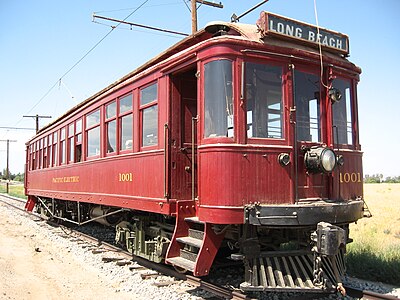
The Pacific Electric Railway Company, nicknamed the Red Cars, was a privately owned mass transit system in Southern California consisting of electrically powered streetcars, interurban cars, and buses and was the largest electric railway system in the world in the 1920s. Organized around the city centers of Los Angeles and San Bernardino, it connected cities in Los Angeles County, Orange County, San Bernardino County and Riverside County.
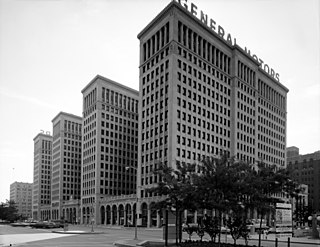
The General Motors streetcar conspiracy refers to the convictions of General Motors (GM) and related companies that were involved in the monopolizing of the sale of buses and supplies to National City Lines (NCL) and subsidiaries, as well as to the allegations that the defendants conspired to own or control transit systems, in violation of Section 1 of the Sherman Antitrust Act. This suit created lingering suspicions that the defendants had in fact plotted to dismantle streetcar systems in many cities in the United States as an attempt to monopolize surface transportation.

The Interurban is a type of electric railway, with streetcar-like electric self-propelled rail cars which run within and between cities or towns. The term "Interurban" is usually used in North America, with other terms used outside it. They were very prevalent in North America between 1900 and 1925 and were used primarily for passenger travel between cities and their surrounding suburban and rural communities. The concept spread to countries such as Japan, the Netherlands, Switzerland, Belgium, Italy and Poland. Interurban as a term encompassed the companies, their infrastructure, their cars that ran on the rails, and their service. In the United States, the early 1900s interurban was a valuable economic institution. Most roads between towns and many town streets were unpaved. Transportation and haulage was by horse-drawn carriages and carts. The interurban provided reliable transportation, particularly in winter weather, between the town and countryside. In 1915, 15,500 miles (24,900 km) of interurban railways were operating in the United States and, for a few years, interurban railways, including the numerous manufacturers of cars and equipment, were the fifth-largest industry in the country. By 1930, most interurbans in North America were gone with a few surviving into the 1950s.

The San Diego Electric Railway (SDERy) was a mass transit system in Southern California, United States, using 600 volt DC streetcars and buses.
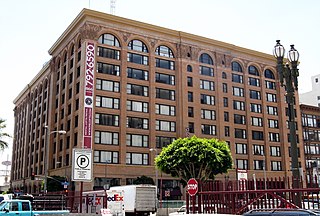
The historic Pacific Electric Building, opened in 1905 in the core of Los Angeles as the main train station for the Pacific Electric Railway, as well as the company's headquarters; Main Street Station served passengers boarding trains for the south and east of Southern California. The building was designed by architect Thornton Fitzhugh. Though not the tallest in Los Angeles, its ten floors enclosed the greatest number of square feet in any building west of Chicago for many decades. Above the train station, covering the lower floors, were five floors of offices; and in the top three was the Jonathan Club, one of the city's leading businessmen's clubs introduced by magnates from the Northeast. After the “Great Merger” of Pacific Electric into Southern Pacific Railroad in 1911, the PE Building became the home of Southern Pacific in Los Angeles. In 1925, a second electric rail hub, the Subway Terminal, was opened near Pershing Square to serve the north and west.
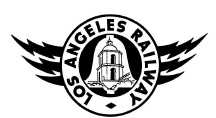
The Los Angeles Railway was a system of streetcars that operated in Central Los Angeles and surrounding neighborhoods between 1895 and 1963. The system provided frequent local services which complemented the Pacific Electric "Red Car" system's largely commuter-based interurban routes. The company carried many more passengers than the Red Cars, which served a larger and sparser area of Los Angeles.

The Peninsular Railway was an interurban electrified railway in the U.S. State of California in the United States of America. It served the area between San Jose, Los Gatos, and Palo Alto, comprising much of what is today known as "Silicon Valley". For much of its existence it was a subsidiary of the Southern Pacific Railroad.

Streetcars or trolley(car)s were once the chief mode of public transit in hundreds of North American cities and towns. Most of the original urban streetcar systems were either dismantled in the mid-20th century or converted to other modes of operation, such as light rail. Today, only Toronto still operates a streetcar network essentially unchanged in layout and mode of operation.

South Pasadena Local was a local streetcar line operated by the Pacific Electric Railway between Downtown Los Angeles and South Pasadena, California by way of the Arroyo Seco Route. This was one of four lines that connected the two cities.
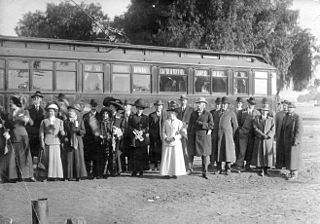
The San Fernando Line was a part of the Pacific Electric Railway system in Los Angeles County, California. It was designed to increase the reach of public transportation from the Downtown Los Angeles and Hollywood into the San Fernando Valley, to support land speculation and development expanding Los Angeles.
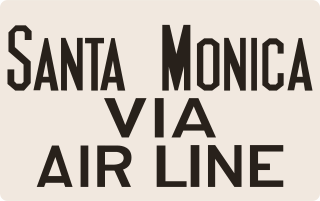
The Santa Monica Air Line was an interurban railroad operated by the Pacific Electric between Santa Monica and downtown Los Angeles. Electric passenger service operated over the line between 1908 and 1953. After abandonment as a freight railroad, most of the route was converted to light rail for use by the Metro E Line.

The Owensmouth Line was a Pacific Electric interurban service that connected the San Fernando Valley to Downtown Los Angeles. The route was largely developed as the result of real estate speculation.
5 or the 5 Car was a streetcar line operated by the Los Angeles Railway, later named the Los Angeles Transit Lines, and by the Los Angeles Metropolitan Transit Authority. From 1920 to 1932, this route was known as the E Car. This was changed as part of a method to distinguish routes that lacked loops at their termini. Consequently, the 5 Car was unique during the LAMTA era in that it did not use PCC streetcars. It used buses from 1955 to 1964, transferring from LATL in 1958, then splitting the line in two in 1961, until all lines were turned over to SCRTD in August 1964.
F was a streetcar line in Los Angeles, California. It was operated by the Los Angeles Railway from 1911 to 1955.
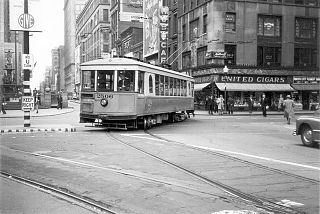
Streetcars operated by the Cincinnati Street Railway were the main form of public transportation in Cincinnati, Ohio, at the end of the 19th century and the start of the 20th century. The first electric streetcars began operation in 1889, and at its maximum, the streetcar system had 222 miles (357 km) of track and carried more than 100 million passengers per year. A very unusual feature of the system was that cars on some of its routes traveled via inclined railways to serve areas on hills near downtown. With the advent of inexpensive automobiles and improved roads, transit ridership declined in the 20th century and the streetcar system closed in 1951.

The Los Angeles Pacific Railroad (1896−1911) (LAP) was an electric public transit and freight railway system in Los Angeles County, California. At its peak it had 230 miles (370 km) of track extending from Downtown Los Angeles to the Westside, Santa Monica, and the South Bay towns along Santa Monica Bay.

Cable car street railways first began operating in Los Angeles in 1885 and lasted until 1902, when the lines were electrified and electric streetcars were introduced largely following the cable car routes. There were roughly 25 miles (40 km) of routes, connecting 1st and Main in what was then the Los Angeles Central Business District as far as the communities known today as Lincoln Heights, Echo Park/Filipinotown, and the Pico-Union district.

The Venice Boulevard Line was a local streetcar line of the Pacific Electric. It operated between Downtown Los Angeles and Vineyard Junction, where riders could transfer to interurban cars. Nearly all Venice Short Line cars did not accept local passengers, leaving this as the primary streetcar service along its namesake boulevard.
Streetcars in Redlands transported people across the city and region from 1889 until 1936. The city's network of street railways peaked around 1908 before the patchwork of separate companies was consolidated under the Pacific Electric.

San Pedro featured a network of streetcars between 1903 and 1958. The establishment of the Port of Los Angeles in the early 1900s spurred the development of the nearby city, and electric streetcars provided local transit services for workers and later military personnel. Pacific Electric was the primary operator in the city.



